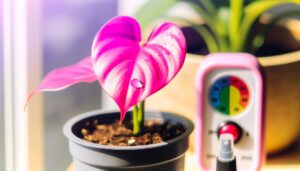White Princess Philodendron Care
The White Princess Philodendron, a tropical plant, requires careful maintenance for optimal health. Bright, indirect light encourages variegation, while well-draining, peat-based soil promotes growth.
Maintaining a balanced watering schedule helps mitigate issues like root rot. Proper pruning techniques in spring or early summer and timely repotting every 2-3 years ensure robust growth.
In addition, early prevention and treatment of common pests and diseases like aphids, mealybugs, and leaf spot disease are essential to its care. For more thorough tips and specialized care instructions that can help your White Princess Philodendron thrive, consider exploring further.
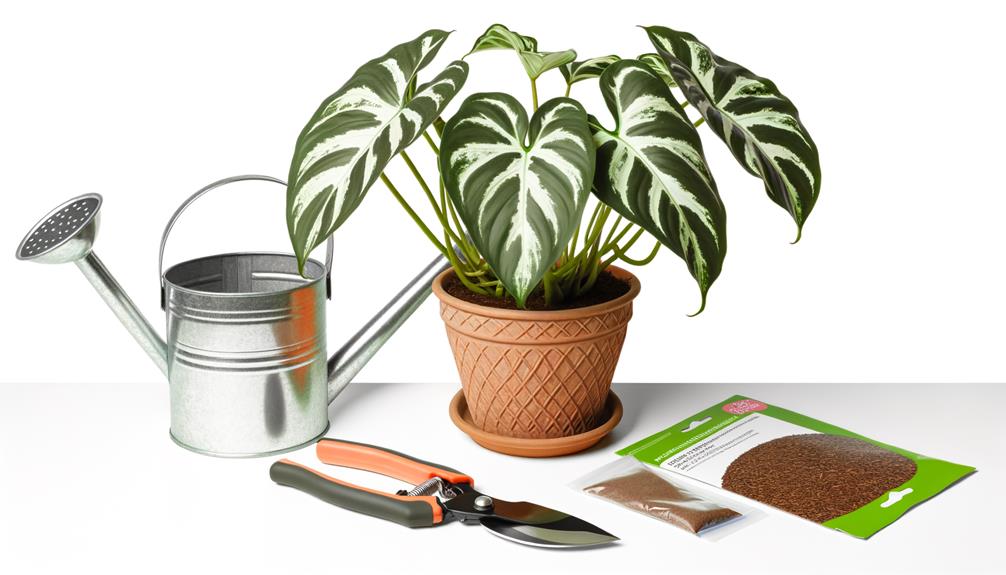
Key Takeaways
- Ensure optimal lighting by placing the White Princess Philodendron near an east or north-facing window with bright, indirect light.
- Water the plant only when the top inch of the soil is dry, adjusting frequency with seasonal changes to prevent over or under-watering.
- Use well-draining, peat-based soil with a pH range of 6.0 to 7.0, incorporating peat moss, perlite, orchid bark, and activated charcoal.
- Prune the plant during its active growth phase, removing damaged leaves and trimming overgrown vines, and repot every 2-3 years.
- For pest control, use insecticidal soap on aphids, wipe mealybugs with alcohol-soaked cotton, and treat root rot and leaf spot disease promptly.
Understanding White Princess Philodendron
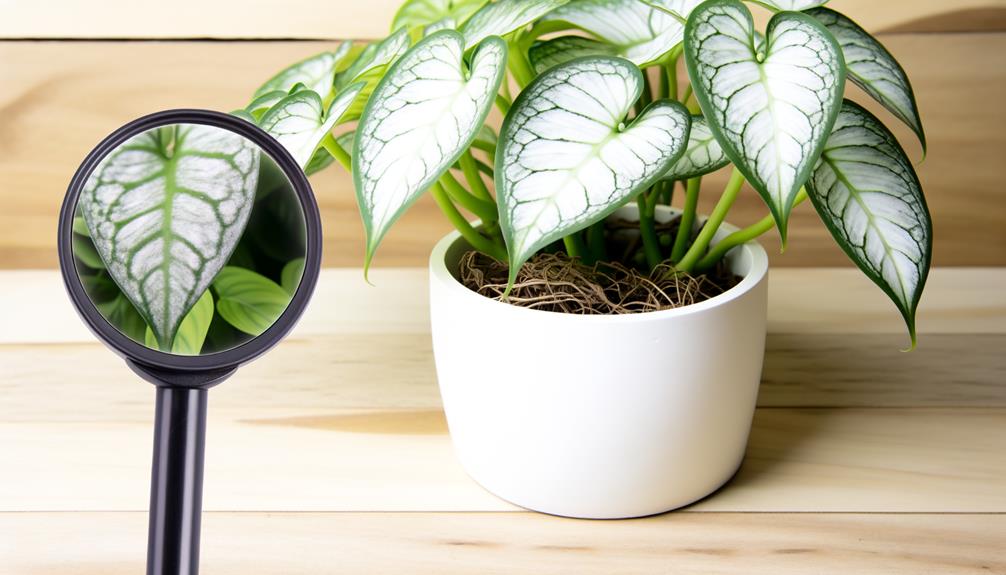
The White Princess Philodendron, scientifically known as Philodendron 'White Princess', is a unique species of tropical plant renowned for its lush foliage characterized by a stunning contrast of deep green and radiant white.
This species is a part of the Araceae family, which is predominant in tropical regions. As an aroid species, it displays a unique growth pattern known as 'epiphytic' where it grows on other plants or trees rather than in soil.
Although it can adapt to different environments, it thrives best in conditions that mimic its natural tropical habitat. Its striking variegation, coupled with its modest growth rate, makes it a valuable addition to any plant collection.
Proper understanding of its growth habits and needs is essential for those wishing to care for this exquisite species.
Optimal Lighting Conditions
Illumination plays an important role in the healthy growth and development of the White Princess Philodendron, requiring bright, indirect light for best photosynthesis and variegation expression.
| Lighting Condition | Impact on Growth | Ideal Action |
|---|---|---|
| Bright, indirect light | Stimulates photosynthesis, enhances variegation | Position near east or north-facing window, use sheer curtains to diffuse light |
| Direct sunlight | Can cause leaf burn, wilting | Avoid direct exposure, especially during peak sunshine hours |
| Low light | Slows growth, reduces variegation | Supplement with artificial light if necessary |
Understanding the light preferences of this plant is crucial for creating an environment conducive to its health and wellbeing. Serving as responsible caretakers means ensuring we provide the correct lighting conditions, adjusting as necessary to promote the plant's best growth.
Watering Your Philodendron
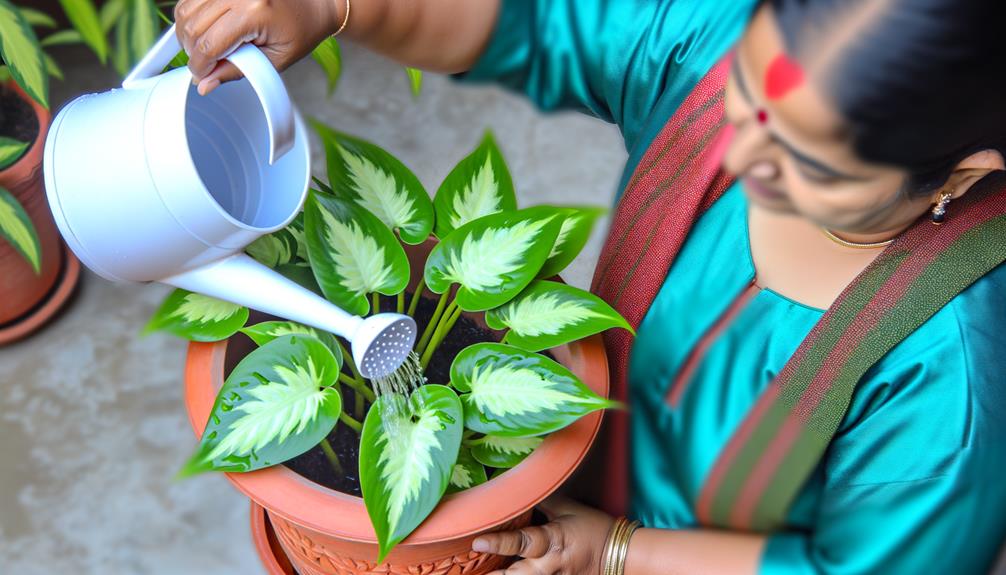
Proper hydration is crucial to the health and liveliness of your White Princess Philodendron. This section will outline the suggested watering frequency for this species and provide insight into the common signs of overwatering.
The objective is to equip you with the knowledge to maintain a balanced moisture level for your Philodendron, fostering its best growth.
Correct Watering Frequency
For best growth and health of your White Princess Philodendron, maintaining an appropriate watering frequency is of utmost importance. This tropical plant thrives when its soil remains lightly moist, but not waterlogged.
A general rule is to water your plant once the top one inch of soil feels dry to the touch. This typically falls within a weekly to bi-weekly schedule, depending on environmental conditions like temperature and humidity.
Overwatering can lead to root rot, a serious disease that can be fatal for your plant. Conversely, underwatering will cause the philodendron to lose its vibrant color and energy.
As a caretaker, adjusting watering frequency according to seasonal changes promotes a healthy, flourishing White Princess Philodendron.
Identifying Overwatering Signs
Recognizing the signs of overwatering is important in maintaining the health of your White Princess Philodendron, as this condition can lead to damaging issues such as root rot. Key indicators of excessive watering include yellowing leaves, a common symptom of both overwatering and underwatering. To discern between the two, observe the lower leaves. If they are yellow and wilted, overwatering is likely the culprit.
Additionally, chronically overwatered plants often develop brown, mushy roots that emit a foul odor, a clear sign of root rot. Overwatering not only drowns the roots, but also creates a conducive environment for harmful fungi and bacteria. It is important to understand and promptly address these signs to maintain the plant's health.
Ideal Soil and Potting Mix
What is the perfect soil composition for a thriving White Princess Philodendron, you might ask?
These plants prefer a well-draining, peat-based potting mix with a pH range of 6.0 to 7.0. A blend of 50% peat moss, 20% perlite, 20% orchid bark, and 10% activated charcoal is ideal.
The peat moss provides necessary acidity, while the perlite improves drainage. Orchid bark adds texture, promoting air circulation around the roots, and activated charcoal aids in filtering out toxins and impurities.
The potting mix should be light and airy, so it retains some moisture but allows excess water to easily drain away. This prevents the roots from becoming waterlogged, which can lead to root rot – a common issue in poorly drained soil.
Pruning and Repotting Tips
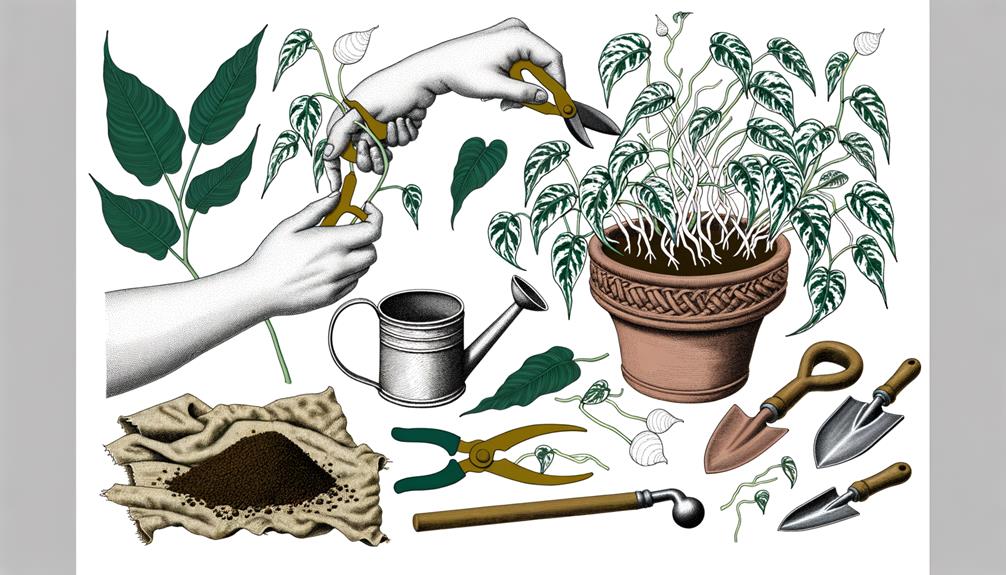
To maintain the health and aesthetics of your White Princess Philodendron, it is important to apply correct pruning techniques and understand the process of successful repotting.
Pruning is not simply about removing dead leaves but involves a strategic approach to promote growth and prevent disease.
When it comes to repotting, knowing when and how to do this vital task can greatly impact the plant's overall wellbeing and longevity.
Correct Pruning Techniques
Employing the right pruning techniques can greatly enhance the health and aesthetic appeal of your White Princess Philodendron, ensuring ideal growth and vigor.
Pruning should ideally be performed during the plant's active growth phase, typically in spring or early summer. Use clean, sharp shears to make precise cuts, minimizing damage to the plant. Remove yellowed or damaged leaves first, making the cut near the base of the leaf stem. This helps redirect the plant's energy towards healthy growth.
Also, trim back overgrown vines to maintain the desired shape and size of the plant. Be careful not to over-prune, as this can stress the plant.
Lastly, always sanitize your tools before and after use to prevent the spread of disease.
Proper pruning not only enhances the plant's beauty but also promotes its overall health.
Successful Repotting Process
Mastering the successful repotting process involves a blend of timing, soil selection, and careful handling of your White Princess Philodendron. This plant prefers being root-bound, so repotting should only occur every 2-3 years or when roots densely fill the pot.
Select a pot 2 inches larger in diameter than the current one. Use a well-draining soil mix containing peat moss, perlite, and compost which provides the right balance of moisture retention and drainage.
Before repotting, water your Philodendron thoroughly. Carefully remove the plant from its current pot, ensuring minimal disturbance to the root system.
Place the plant in the new pot, adding soil until the roots are fully covered. Water lightly to settle the plant and soil. This method promotes the health and longevity of your Philodendron.
Dealing With Pests and Diseases
In maintaining the health and strength of your White Princess Philodendron, it is important to promptly identify and address any potential issues related to pests and diseases.
The following table provides a brief overview of common issues and their recommended solutions.
| Problem | Solution |
|---|---|
| Aphids | Prune infested leaves and use insecticidal soap. |
| Mealybugs | Wipe off with a cotton ball soaked in rubbing alcohol. |
| Root Rot | Cut off affected roots and repot in fresh, well-draining soil. |
| Leaf Spot Disease | Remove affected leaves and treat with a fungicide. |
| Yellow Leaves | Check watering schedule and light conditions. |
Conclusion
To sum up, the White Princess Philodendron's care involves a synthesis of ideal lighting conditions, regular watering, suitable soil mix, and timely pruning.
It's also essential to implement preventive measures against pests and diseases.
By adhering to these care guidelines, the plant's majestic beauty can be preserved, and it can continue to purify the environment, symbolizing a harmonious coexistence between humans and nature.



